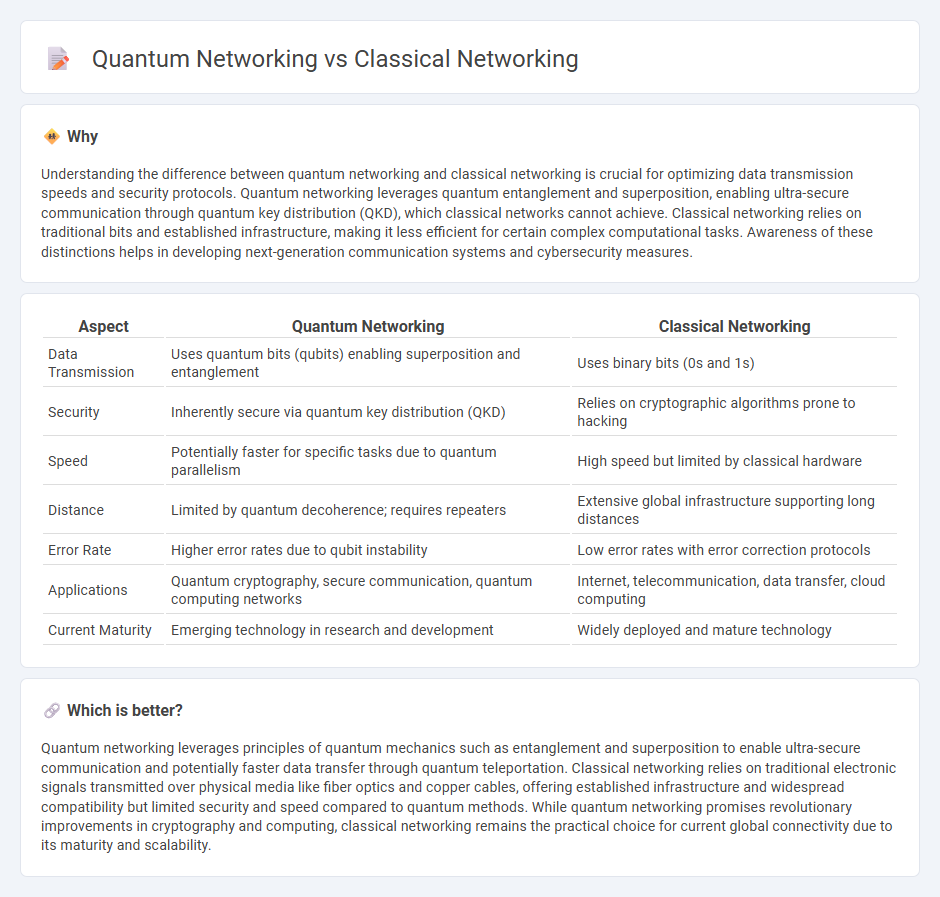
Quantum networking leverages quantum bits (qubits) to enable ultra-secure data transmission through quantum entanglement and superposition, surpassing the speed and security of classical networking's binary data packets. Unlike classical networks reliant on conventional protocols and hardware, quantum networks employ phenomena like quantum key distribution (QKD) for unparalleled encryption. Explore the advancements and implications of these cutting-edge networking technologies for future communication systems.
Why it is important
Understanding the difference between quantum networking and classical networking is crucial for optimizing data transmission speeds and security protocols. Quantum networking leverages quantum entanglement and superposition, enabling ultra-secure communication through quantum key distribution (QKD), which classical networks cannot achieve. Classical networking relies on traditional bits and established infrastructure, making it less efficient for certain complex computational tasks. Awareness of these distinctions helps in developing next-generation communication systems and cybersecurity measures.
Comparison Table
| Aspect | Quantum Networking | Classical Networking |
|---|---|---|
| Data Transmission | Uses quantum bits (qubits) enabling superposition and entanglement | Uses binary bits (0s and 1s) |
| Security | Inherently secure via quantum key distribution (QKD) | Relies on cryptographic algorithms prone to hacking |
| Speed | Potentially faster for specific tasks due to quantum parallelism | High speed but limited by classical hardware |
| Distance | Limited by quantum decoherence; requires repeaters | Extensive global infrastructure supporting long distances |
| Error Rate | Higher error rates due to qubit instability | Low error rates with error correction protocols |
| Applications | Quantum cryptography, secure communication, quantum computing networks | Internet, telecommunication, data transfer, cloud computing |
| Current Maturity | Emerging technology in research and development | Widely deployed and mature technology |
Which is better?
Quantum networking leverages principles of quantum mechanics such as entanglement and superposition to enable ultra-secure communication and potentially faster data transfer through quantum teleportation. Classical networking relies on traditional electronic signals transmitted over physical media like fiber optics and copper cables, offering established infrastructure and widespread compatibility but limited security and speed compared to quantum methods. While quantum networking promises revolutionary improvements in cryptography and computing, classical networking remains the practical choice for current global connectivity due to its maturity and scalability.
Connection
Quantum networking integrates with classical networking by using classical communication channels to transmit measurement results necessary for quantum state verification and error correction. Quantum repeaters rely on classical networks to coordinate entanglement distribution over long distances, enabling scalable quantum internet infrastructure. This hybrid approach enhances overall network security and performance by combining quantum cryptographic protocols with established classical routing and signaling techniques.
Key Terms
Source and External Links
Integrating Quantum Networks with Classical Networks - Classical networks refer to traditional networks like LANs, WiFi, cellular, optical fiber, satellite, and the internet that send classical bits (ones and zeroes) typically via strong optical, electrical, or radio pulses, contrasting with quantum networks that communicate using qubits leveraging quantum properties such as superposition and entanglement.
Classical internet vs. quantum internet: How do they differ? - The classical internet transmits data via TCP/IP protocol with unique IP addressing and packet routing, while quantum networks are still experimental and use quantum protocols; hybrid networks are expected to combine classical and quantum elements to enhance security and performance.
Integrating Quantum Networks and Classical Networks: the Physical ... - Quantum networks will not replace classical networks but will augment them, working together especially for advanced secure communication by combining classical encryption methods with quantum key distribution over integrated network layers.
 dowidth.com
dowidth.com